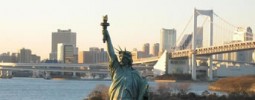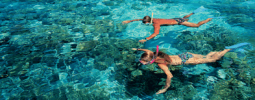Halong Bay consists of thousands little islands in the north east of Vietnam. The islands are located in a bay in the Gulf of Tonkin. Halong Bay means literally translated Bay of Descending Dragons, probably referring to the scenic rock formations. Halong Bay belongs to different districts of Vietnam and is listed as a World Heritage Site of UNECO.
Halong Bay has two kinds of islands, limestone and schist. There are 1.969 limestone karsts and islets, 989 of them have names. The limestone in the bay has gone through 500 million years of formation. The islands will give you a feeling of magic and mystic, although you do have to forget about the tourist boats. The highly concentrated zone of stone islands form the center of Halong Bay. It is a natural wonder and inspiring place with beaches, caves and grottoes.
Most tourists reach Halong Bay by tour, pre-purchased in Hanoi or other cities in the region. The prices vary depending on the quality of the boat, crew, food and additional activities. It is better to deal directly with a tourist company that sells the tickets to Halong Bay. Most tours include overnight stays at a junk or hotel on Cat Ba Island. Halong Bay offers many activities, such as fishing, swimming and kayaking.
Travelers to Halong Bay need a valid passport and visa. If you don’t want to take the boat, you could make use of a helicopter charter service on Saturday. These services departure from Gia Lam Airport in Hanoi.
The Vietnamese kitchen has been influenced by alien domination and exchange of products. China, Mongolia, Thailand, Cambodia, Laos and France have left their culinary marks. Despite this the Vietnamese kitchen has its own character. It is less sharp than Thai kitchen, but qua taste less pure than the South-Chinese kitchen. However, if you only eat in a hotel you will never learn the Vietnamese kitchen. Simple, cheap and tasty are the dishes in soup kitchens alongside the streets and on the markets.
Rice is a life symbol for the Vietnamese people. On any market you will see many different qualities and varieties of rice. The grains differ in length, shape, color and scent. Normally rice is steamed. You should eat white long grain rice with a sharp tip. As a tourist you will almost by itself get fork and knife. You will also find fish and sea fruits at the markets.
The Vietnamese barely use oil, but they add the spice nuoc mam to almost all dishes as a replacement for salt. A typical feature of the Vietnamese kitchen is the merging of complementary ingredients. The quality of beef isn’t always as good, but you can be sure that pork and chicken is very tender and tasteful.
Every region in Vietnam has its own specialities and menus. However, some dishes are found everywhere: Pho (bouillon) served with bo (beef), tom (shrimps) or ga (chicken) – banh cuon tom viet nam (Vietnamese egg rolls with pork and shrimps) – chao tom voi thit lon xay (mix of cut shrimps and pork). In Hue you should try banh khoai and bun bo or bun ga (bouillon with stuffing).
When it comes to drinks, mineral water, coke, beer (333) and alcohol are available everywhere. You should avoid wine because of the poor quality. Tea and coffee aren’t common drinks for the Vietnamese.
The Vietnamese know that they can make a lot of money with kitsch and small things. Therefore for a long time they forgot about traditional art handwork. Fortunately this craft is beginning to come back again. The Vietnamese souvenir business is still small compared to neighbor countries. There is limited offer expect for cities as Saigon, Hanoi and Hue.
The most important craft for the Vietnamese is pottery art and lacquer work. These handwork crafts are centuries old. All kinds of products as cupboards, plates and vases are being lacquered with resin. Wooden or bamboo objects get eleven layers of resin. The last layer is polished with chorister powder and limestone. Sometimes people engrave ornaments into the resin layers.
In souvenir shops you will also find many silk painted products. The fine scars and blouses, rags or postcards are less than what you should pay for them at home. Most beautiful are the special aodai, traditional clothing of Vietnamese women. Silk weaving is also very popular. You should go to Hanoi for good tailors.
In the north of Vietnam they make jackets or coats of heavy, shiny velvet, stitched with silk and fitted with sequin or gold stitching. When you would like to buy such a jacket or coat, you should take your time for fitting!
Other crafts in Vietnam are embroidery, lacework, painting and woodcraft. Embroidery and lacework is mostly offered in Hanoi. There are also more and more art galleries in Hanoi. In Hoi An, a place south of Danang, almost all streets are covered with art galleries. In Saigon there are artists who are experts in copying famous paintings. So you could get your Van Gogh, da Vinci or Gauguin from them.
Don’t buy antique and products made of turtles and ivory or protected animals and plants! Also make sure you are well informed about which products you can’t import to your own country.
Celebrations were almost prohibited in the strong-communistic period. Only political feasts were an exception. Since Doi Moi the Vietnamese got back to feasting again. Festivals involve impressive wealth of colors, a lot of spectators and a colorful program.
The Vietnamese calendar is a mix of the sun calendar (Western Gregorian year of 365 days) and the moon calendar. A moon year has 355 days. The Vietnamese moon calendar is a match with the old Chinese moon calendar and they started counting 2637 years before our calendar. The sun calendar is established through the republican revolution of 1912.
Vietnam celebrations & festivals include,
Tet, the Vietnamese New Year. People feast for a whole week (three official festival days): family meetings, annual fairs, parades and lots of presents. Since a few years fireworks are forbidden. If one can afford it, people let the champagne corks pop. This is for the Vietnamese our form of Christmas. When you travel through Vietnam in this period, you should take full hotels, transportation, sights and closed shops into account.
Thanh Minh, the fifth day of the third month is dedicated to the ancestor honouring. Graves are decorated with flowers, incense candles and paper objects.
Phat Dan, on the eight day of the fourth month the Vietnamese celebrate the birth date of Buddha. Religious people spend this day in the pagoda that is decorated with lanterns. In the evening processions are held.
Tet Doan Ngu, the highest point of the sun Is celebrated on the fifth day of the fifth month. The Vietnamese believe that their energy reaches its highest point. They offer gifts to the angry spirits that spread diseases. They throw dolls into fire as a sacrifice for the god of death.
Trung Nguyen, on the fifteenth day of the seventh month people celebrate the movement of the soul. In houses and temples people give sacrifices in form of gifts and food to the restless souls of forgotten dead.
Trung Thu, this is a feast for children on the fifteenth day of the eight-month. In a procession the children walk through the streets with lanterns in the shape of boats, unicorns, dragons and more.
Birth date of Confucius, the 28th day of the ninth month.
Thong Tan Tet, this is the celebration of the harvest on the tenth day of the tenth month. Children will give their parents presents, patients to their doctors, pupils to their teachers and so on.
Oc Om Bok, on the fifteenth day of the tenth month the Khmer people in the south of Vietnam have their traditional celebration of the harvest. They hold spectacular boat races, in Soc Trang for example. In the next night they have the ceremony in honor of the moon, Le Cung Trang.
Hanoi is the capital of Vietnam. The city is situated on the bank of the Red River which is in the North of the country. While Hanoi is not the largest city in the country (which is Ho Chi Minh) it has had a rich history. It has been inhabited since 3000 B.C and has served the government seat for nearly 1000 years. Hanoi has a population of 3.4 million people.
Once arrived at Noi Bai Airport it takes about an hour to get into town, this ride offers you glimpses of modern Vietnamese life; farmers in their fields, great rivers, modern highways that occasionally become bumpy roads. Somehow the sun setting seems perfect as it always disappears into the cornfields horizon. Once into the city you are surrounded by roadside artisans, shops and taverns, commuters on bicycles, cyclos and motorbikes. Modern buildings appear from nowhere and look so out of place, you start to wonder if they dropped from the sky.
To leave the tourist attractions and city life behind, be warning this is for adventurous only! rent a Russian Minsk and follow the road towards the hills. This route offers one of the world’s most stunning scenery which stops in hill tribe villages, including a motorcyclist’s dream of long mountain roads. Most of these roads are unpaved, alternately dusty and dangerously muddy. At full throttle this track can be completed within a week but most adventurous travelers take at least two weeks. There’s a possibility to do the tour by jeep also.
Travelers to Hanoi need a valid passport and visa. US passport holders must have a valid passport and a visa is required. Travel in Vietnam is generally safe and violent crime is uncommon. Pick-pocketing is rife, and drive-by purse snatching is a common trick. The summer months are between May and September, though rain can be expected.








